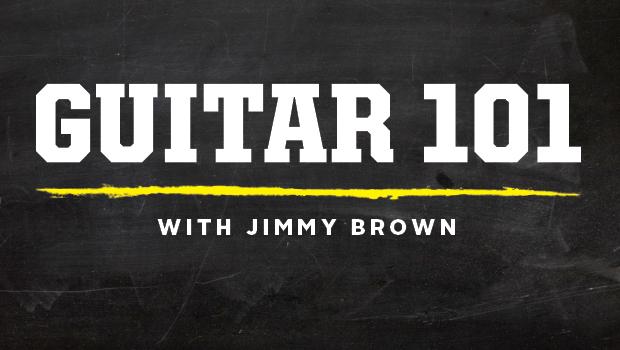Guitar 101: Learning Harmony Through Six-Note Hexatonic Scales, Part 3

At the end of my last column I promised you that we would continue surveying some more cool-sounding hexatonic (six-note) scales, with the emphasis gradually shifting toward the exotic.
As you may recall, we left off with the Mixolydian-flavored E "leprechaun" scale (E F# G# A B D), which we summoned by combining E major (E G# B) and D major (D F# A) triads (in theoretical terms, "1 major" and "flat 7 major"). I hope you’ve been playing around and having fun with that intriguing sound because I’ve got a whole bag full of tasty hexatonic "ear candy" for you to chew on. We’ll resume our exploration of six-note scales by first going back to hexatonic "home base," using the now-familiar E major and F# minor (F# A C#) triads as our reference point (these would be considered "1 major" and "2 minor" in the key of E).

o conjure a seductive Lydian major tonality—with the emphasis on the raised or "sharped" fourth—minus the extra harmonic "baggage" (in this case, the seventh), all you need to do is combine/alternate E major (E G# B) and F# major (F# A# C#) triads ("1 major-2 major"), as FIGURE 2 illustrates in the form of a harmonized chord-scale. I like to call this the "Miracle Bra" scale (not to be confused with the 1 major-2 minor "Wonder Bra" scale—a.k.a. the major hexatonic or "gospel" scale—that we checked out in the May 2001 issue) because, like the "Wonder Bra" scale, it sounds beautiful and uplifting, but it also imparts a magical and mysterious vibe.

FIGURE 3 is a sinewy single-note lick in E that uses the Lydian-like "Miracle Bra" scale and legato phrasing to create a rolling, fluid sound. Notice the interesting contour of the run and the way it begins in the seventh position, meanders its way up to the ninth position and ends in the 12th position.

Using a somewhat different melodic approach, FIGURE 4 is an ambitious-sounding classical-style arpeggio sequence that builds harmonic tension as it climbs up the neck and alternates between E and F# major triads (over a low E pedal tone) before finally resolving to B. Again, note the use of position shifts as the pattern ascends.
By now you’re probably starting to see that there are basically two musically viable approaches to applying these hexatonic scales: they can be played in a linear fashion like a mode (as in FIGURE 3), or as alternating chords or arpeggios (as in FIGURES 2 and 4). A useful and economical variation of the latter approach is to use alternating doublestops instead of triads, as demonstrated in FIGURE 5. I must say, this is an effective and entertaining way to learn and review intervals.

We’re quickly running out of space here, so I’ll end this month’s lesson by showing you one more spine-tingling hexatonic in the key of E—what I like to call the "Iberian" scale (E F G# A B D) (see FIGURE 6). This elegantly exotic flameco-flavored tonality is summoned by combining or alternating E major (E G# B) and D minor (D F A) triads ("1 major" and "flat-7 minor" relative to E). The union of these two sets of notes yields a hexatonic scale that’s one note short of being identical to the seven-note E Phrygian-dominant mode (E F G# A B C D). The six-note "Iberian" scale sounds cool when played up the neck in open-interval doublestops, either on plucked non-adjacent strings, as in FIGURE 7, or on adjacent strings using mandolin-style tremolo strumming, as in FIGURE 8.

We’ll continue our study of hexatonic scales next time and learn a fun and easy way to transpose them to different keys and use them over two-chord vamps. Until then, take the ones you’ve learned thus far and try coming up with cool-sounding patterns using single notes, doublestops or alternating triads while experimenting with different phrasing schemes and fretboard positions.

Get The Pick Newsletter
All the latest guitar news, interviews, lessons, reviews, deals and more, direct to your inbox!
Over the past 30 years, Jimmy Brown has built a reputation as one of the world's finest music educators, through his work as a transcriber and Senior Music Editor for Guitar World magazine and Lessons Editor for its sister publication, Guitar Player. In addition to these roles, Jimmy is also a busy working musician, performing regularly in the greater New York City area. Jimmy earned a Bachelor of Music degree in Jazz Studies and Performance and Music Management from William Paterson University in 1989. He is also an experienced private guitar teacher and an accomplished writer.










![Joe Bonamassa [left] wears a deep blue suit and polka-dotted shirt and plays his green refin Strat; the late Irish blues legend Rory Gallagher [right] screams and inflicts some punishment on his heavily worn number one Stratocaster.](https://cdn.mos.cms.futurecdn.net/cw28h7UBcTVfTLs7p7eiLe.jpg)
